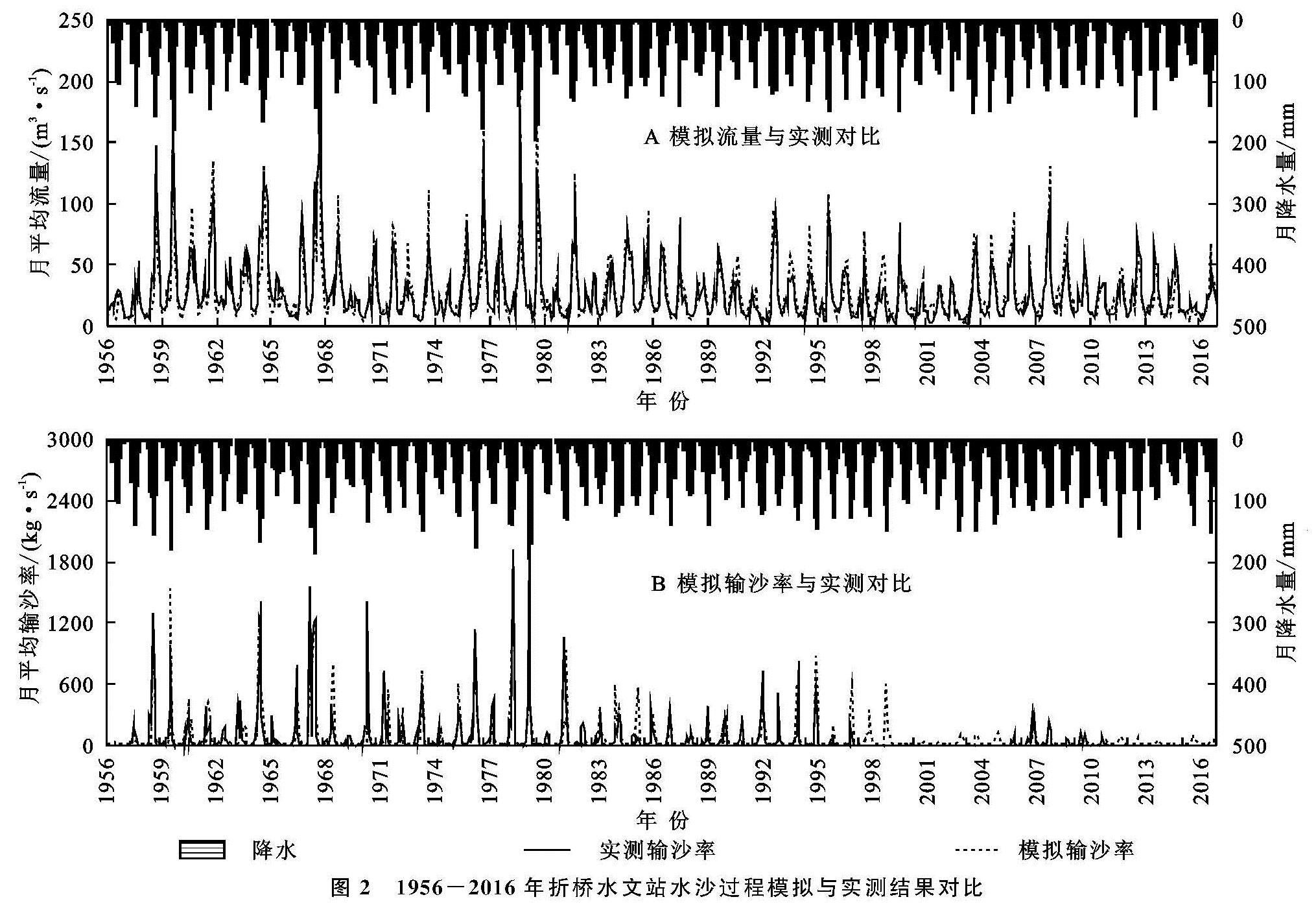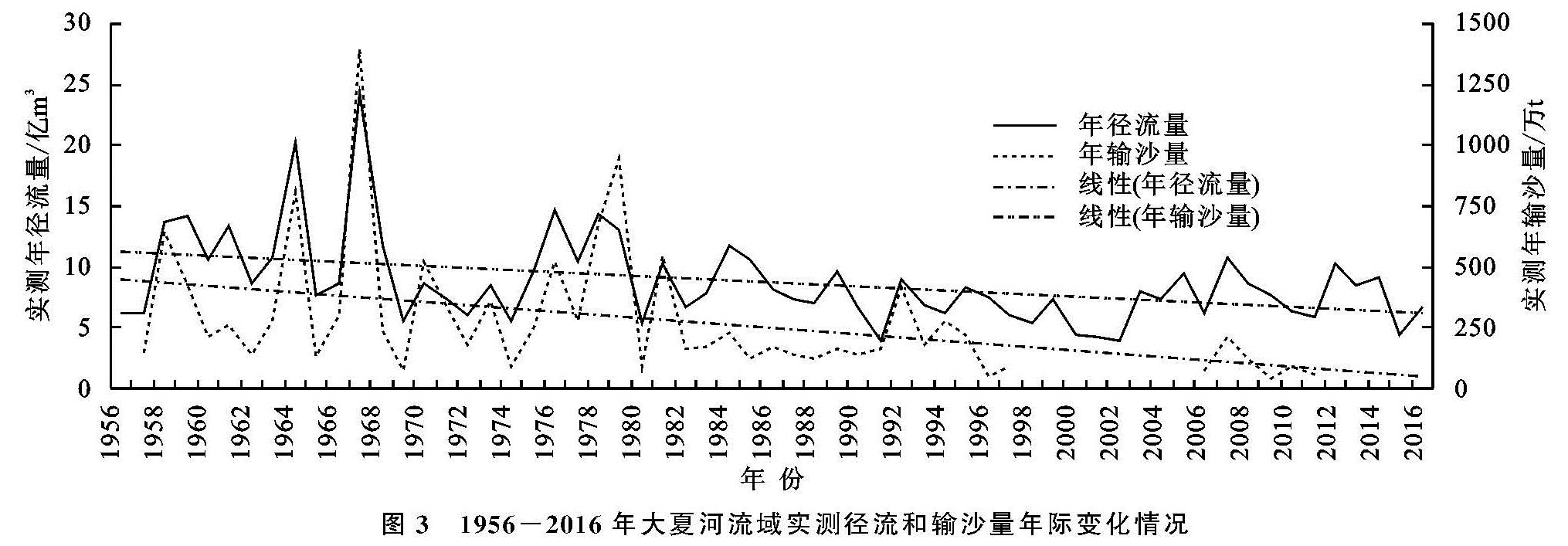3.1 实测水沙过程规律分析
图3为大夏河流域实测年径流量和年输沙量的变化情况,最大年径流量为24.35亿m3(1967年),最小年径流量为3.85亿m3(1991年),最大年径流量是最小年径流量的6.3倍; 最大年输沙量为1 391.48万t(1967年),最小年输沙量为44.71万t(2009年),最大年输沙量是最小年输沙量的31.12倍; 径流和输沙变化差异极大。根据Mann-Kendall趋势分析法分析,年径流量整体上呈减少趋势,变化率为-0.85亿m3/10 a,1994年后年径流量下降趋势显著; 年输沙量整体上呈减少趋势,变化率为-66.25万t/10 a,1990年后年输沙量下降趋势显著。
图3 1956-2016年大夏河流域实测径流和输沙量年际变化情况
图4为大夏河流域实测年径流量和年输沙量Mann-Kendall突变性检验结果,对检验结果进行分析,在给定显著性水平为0.05(U0.05=1.96)的条件下,对于年径流量,标准正态分布序列UF和反序列UB在1984—1985年出现交点,年径流量发生突变,下降趋势显著; 对于年输沙量,UF和UB曲线在1987—1988年出现交点,该段时间年输沙量发生突变,且下降趋势显著。综上所述,年径流量和年输沙量均在1980s的中期发生突变。后续分析中,按照年输沙量出现的拐点分段,以1956—1987年为基准期,1988—2018年为变化期,对水沙过程变化规律进行分析。
图4 1956-2016年大夏河流域实测径流和输沙量Mann-Kendall检验
图5为基准期和变化期的实测水沙过程年内变化情况。对于输沙年内分布过程,折桥站的年内水沙过程曲线呈明显“单峰型”,但河道径流过程与输沙过程不完全同步。
最大月径流量出现在9月,而最大月输沙率出现在8月; 径流量减幅最大的月份也出现在9月,而输沙率减幅最大的月份也出现在8月。由此推断,大夏河产流产沙机制存在较大的不同。
图5 1956-2016年大夏河流域基准期和变化期实测水沙过程年内变化情况
通过计算,折桥站的多年平均输沙量282万t,主要集中在汛期的7—9月,占年输沙量的79%。变化期(1988—2018年)相较于基准期(1956—1987年)的径流量和输沙量均在减小,变化期的年径流量较基准期减少31%,输沙量减小57%,输沙量的减小幅度是径流量的1.8倍; 在输沙量最大的7—9月,输沙量月均减小幅度为56%,径流量月均减小幅度为32%,与全年基本一致; 在输沙量最大的8月,输沙量月均减小幅度为58%,径流量月均减小幅度为33%,与全年基本一致; 分析在1—6月和10—12月的输沙量变化,相较于基准期,变化期的径流量和输沙量同汛期一样均在减少,该9个月的输沙量减少52%,径流量减少29%,与全年基本一致。
3.2 气象要素和土地利用变化情况
表3和图6为大夏河流域在基准期与变化期各影响因素变化情况。变化期内的年均气温和月均气温较基准期均呈增加趋势,流域多年平均气温1.91℃,变化期较基准期增加0.80℃; 其中,7月、8月的月均气温为年内最大温度,多年平均月均气温分别为11.88℃,11.38℃,变化期内月均气温较基准期分别增加0.90℃,0.76℃; 1月、12月为年内最低月均气温,多年平均月均气温分别为-9.63℃,-8.04℃,变化期内平均月均气温较基准期分别增加0.96℃,0.96℃。
大夏河流域多年平均年降水量525.33 mm。分析降水、径流、输沙年内过程,发现最大月降水量出现在7—8月,略早于最大月输沙量(8月),早于最大月径流量(9月)。可以推断,输沙量不仅与河道径流量有关系,还跟坡面的产流、产沙量有关系,8月降水量最大,推断是8月输沙量最大的原因,在后文模型模拟中将对此进行分析。
变化期的多年平均降水量较基准期变化幅度很小,两个时期的年均降水变化幅度几乎为0,7月和8月为年内最大降水月,占年降水量的40%,分析这两个月发现,变化期8月的降水较基准期减少11.32 mm,下降幅度10%; 变化期7月降水较基准期增加0.65 mm,增加幅度只有1%。
对于土地利用,大夏河流域林地、草地、裸地、农田面积占比分别为30.6%,45.2%,17.8%,5.3%,余下的1.1%为水域和城镇地表面积,所占比例较小。变化期相较基准期,林地减少面积与草地增加面积的变化幅度较大且变化量相当,裸地、农田面积变化总量较小,见表3。
表3 1956-2018年大夏河流域基准期与变化期各影响因素对比分析
图6 1956-2018年大夏河流域气温、降水年内分布情况
3.3 气候要素和土地利用变化对水沙过程归因分析
3.3.1 水沙年内分布规律成因分析
流域内蒸散发量的变化受气温、降水等因素影响,在前文3.2节分析得到,7—8月的多年平均月均气温为年内最大月均气温,多年平均月降水量在7月出现峰值,通过对大夏河流域的蒸散发量进行模拟,分析大夏河流域在年内蒸散发量变化过程,大夏河流域年均气温蒸散发量474.06 mm,月蒸散发量在年内随着温度的变化呈明显的先增后减的趋势,在7月达到年内峰值,其中,5—9月的蒸散发量分别为67.7 mm,80.5 mm,92.7 mm,87.5 mm,60.9 mm,共计约占全年总蒸散发量的82%。
通过分析,7月之前的降水量较小,7月降水量较6月增加31.0%,达到年内峰值。由于7月前的土壤较为干燥,含水率较低,土壤吸水率较大,又因为7月的蒸散发量较6月增加13.2%达到年内峰值,在土壤吸水和蒸散发大的双重影响下,径流量在7月并未达到年内峰值,但较6月增幅35.5%; 由于7月较大的降水强度,坡面上的泥沙颗粒受降水形成的坡面水流作用,较容易发生泥沙起动,表层土壤中起动功率较低的泥沙颗粒较容易发生迁移,可较快完成产汇沙过程,导致7月的月输沙量增加较多,输沙量较6月的增加幅度为68.4%。
进入8月后,8月蒸散发量较7月减少5.9%,降水减少2.5%,蒸散发的减少幅度高于降水减少幅度,导致8月的径流量较7月增加23.0%; 由于降水过程的持续,8月的土壤含水率较7月高,泥沙颗粒在水流作用下更容易发生迁移,故年内月输沙量的峰值出现在8月,输沙量较7月增加42.0%。9月的蒸散发量较8月减少43.7%,降水的幅度减少为32.2%,蒸发的减少幅度大于降水,因为9月的实际降水量依然较大,且土壤含水率较7月高,径流在9月出现年内峰值; 随着9月降水量的减少,少部分泥沙起动功率较高的颗粒较难完成泥沙颗粒的迁移,故9月的月输沙量较8月下降明显,下降幅度为124.3%。10月后,随着降水、蒸发的快速下降,径流量和输沙量下降明显,减少幅度分别为24.0%和124.3%。
3.3.2 各项因子贡献分析
图7为大夏河流域径流过程在气温、降水和土地利用等因素影响下的水沙过程年内影响量变化情况,表4为该流域在各因素影响下的水沙过程归因分析。通过分析,降水因素对大夏河流域减水、减沙的影响最大。前文中分析了降水量下降对径流和输沙过程的影响方式,尤其在降水量较大的7—9月,径流量和输沙量下降明显。综合来看,降水对减水、减沙的贡献率分别为-77.0%和-90.0%。
分析气温对径流和输沙过程的影响,变化期内5—10月的月均气温较基准期增加,该时段的气温增加导致流域内蒸散发加大,因此变化期的河道水量较基准期减少,河道水流挟沙力下降,从而输沙量下降; 其他月的气温对径流、输沙的影响较小,对年内变化总体影响不大。综合来看,气温对水沙过程的影响以减水、减沙为主,贡献率分别为-29.7%和-16.5%为主。
分析土地利用因素对水沙过程影响,大夏河流域内土地利用主要以林地、草地和裸地为主,农田面积较小,由于受人类活动的影响,变化期较基准期的林地面积减少量与草地面积增加量变化相当,由于草地的保水固沙能力较林地弱,尤其是植被生长旺盛的5—10月,植被的面积变化导致该区域的综合保水固沙能力减弱,从而土地利用变化对径流量和输沙量的影响呈微弱的增水、增沙作用,贡献率分别为6.7%,6.6%。
图7 各因素对1956-2018年大夏河流域水沙过程的影响
表4 1956-2018年大夏河流域产输沙减少归因分析













